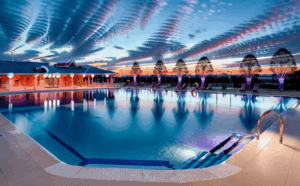Perth Leisure Pool’s recent financial performance has raised concerns, with income significantly lower than projected. This downturn has been attributed to several factors, including the reopening of Dundee’s Olympia pool, which appears to have drawn casual swimmers away from Perth, leading to a 30% reduction in casual swimming revenue. Compounding the issue are ongoing maintenance problems at the 37-year-old Perth Leisure Pool, which has experienced repeated closures in recent months.
These financial difficulties come at a critical time, as Perth and Kinross Council deliberates on the future of the aging facility. The proposed replacement, the PH2O leisure centre at the Thimblerow car park site, has faced strong opposition from community members advocating for renovations to the current Glover Street location. Financial Fallout and Community Impact
Live Active Leisure (LAL), the organization managing local leisure facilities for the council, predicts a deficit ranging from £225,000 to £300,000 for this financial year. While this aligns with their budget projections, their overall customer-generated income is down by 12% compared to the budget. This shortfall isn’t solely attributed to Perth Leisure Pool’s issues; the delayed opening of the new health and fitness facilities at the Dewars Centre also played a role.
Despite seeing approximately 67,000 visits since its September opening, the Dewars Centre gym, equipped with relocated apparatus from the flood-damaged Bell’s Sports Centre, hasn’t fully compensated for the overall revenue decline. LAL’s total fitness memberships have recovered to 88% of pre-flood levels, reaching 3,159 by February’s end, but further growth is needed to address the financial challenges. This situation leaves the future of leisure provision in Perth somewhat precarious, impacting local residents and raising questions about long-term planning for these essential community assets. The implications for sports clubs, families, and individuals who rely on these facilities remain a key concern. Debate Continues Over Perth’s Leisure Landscape
The planned PH2O project at Thimblerow, estimated at £61 million, promises a new leisure hub, and additional funding has been allocated for transforming the flood-hit Bell’s Sports Centre into an unheated events and indoor sports venue. However, this plan is not universally popular. Many residents favor upgrading existing venues, although council reports suggest this option could reach a cost of £105 million, significantly exceeding the Thimblerow budget.
Meanwhile, discussions are underway with local curling clubs regarding the potential transfer of management for the Dewars Centre ice rink and indoor bowling facilities. The complex interplay of these decisions highlights the challenging balancing act faced by the council – weighing financial constraints against community needs and desires. Public consultations, like the one conducted regarding Bell’s Sports Centre, provide valuable input, but reconciling diverse opinions and budgetary realities presents a considerable task. As councillors prepare to revisit these crucial decisions in June, the Perth community eagerly awaits a resolution that secures the future of their cherished leisure and sports facilities.
These financial difficulties come at a critical time, as Perth and Kinross Council deliberates on the future of the aging facility. The proposed replacement, the PH2O leisure centre at the Thimblerow car park site, has faced strong opposition from community members advocating for renovations to the current Glover Street location. Financial Fallout and Community Impact
Live Active Leisure (LAL), the organization managing local leisure facilities for the council, predicts a deficit ranging from £225,000 to £300,000 for this financial year. While this aligns with their budget projections, their overall customer-generated income is down by 12% compared to the budget. This shortfall isn’t solely attributed to Perth Leisure Pool’s issues; the delayed opening of the new health and fitness facilities at the Dewars Centre also played a role.
Despite seeing approximately 67,000 visits since its September opening, the Dewars Centre gym, equipped with relocated apparatus from the flood-damaged Bell’s Sports Centre, hasn’t fully compensated for the overall revenue decline. LAL’s total fitness memberships have recovered to 88% of pre-flood levels, reaching 3,159 by February’s end, but further growth is needed to address the financial challenges. This situation leaves the future of leisure provision in Perth somewhat precarious, impacting local residents and raising questions about long-term planning for these essential community assets. The implications for sports clubs, families, and individuals who rely on these facilities remain a key concern. Debate Continues Over Perth’s Leisure Landscape
The planned PH2O project at Thimblerow, estimated at £61 million, promises a new leisure hub, and additional funding has been allocated for transforming the flood-hit Bell’s Sports Centre into an unheated events and indoor sports venue. However, this plan is not universally popular. Many residents favor upgrading existing venues, although council reports suggest this option could reach a cost of £105 million, significantly exceeding the Thimblerow budget.
Meanwhile, discussions are underway with local curling clubs regarding the potential transfer of management for the Dewars Centre ice rink and indoor bowling facilities. The complex interplay of these decisions highlights the challenging balancing act faced by the council – weighing financial constraints against community needs and desires. Public consultations, like the one conducted regarding Bell’s Sports Centre, provide valuable input, but reconciling diverse opinions and budgetary realities presents a considerable task. As councillors prepare to revisit these crucial decisions in June, the Perth community eagerly awaits a resolution that secures the future of their cherished leisure and sports facilities.


